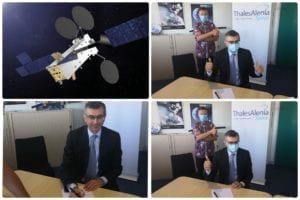
Jakarta/Toulouse, 3 September 2020. — Satelit Nusantara Tiga (SNT) and Thales Alenia Space, a joint venture between Thales (67%) and Leonardo (33%), announced the signature of a Preliminary Work Agreement to start the activities of the Indonesian broadband telecommunication satellite SATRIA.
The full Ka-band SATRIA satellite, to be positioned at 146°E, will carry more than 150 gigabits per second over the full Indonesian territory, Thales Alenia Space said. “Dedicated to narrow the digital divide, SATRIA has the ambition to connect around 145,000 areas including 90,000 schools, 40,000 hospitals and public buildings as well as regional government sites not linked by existing satellite or terrestrial infrastructure. The satellite will contribute to the digital infrastructure developments in Indonesia.”
Thales Alenia Space, acting as prime contractor for this program, initially signed on July 2019 for a consortium led by the domestic satellite operator Pasifik Satelit Nusantara (PSN) on behalf of Indonesia’s Ministry of Communication and Information Technology (Kominfo). Thales Alenia Space said it will deliver the High Throughput Satellite (HTS) based on its Spacebus NEO full electric platform and fitted with a fifth-generation digital processor (5G). The company will also be in charge to provide two satellite control centers (main and backup), the telecommand and telemetry stations, and the ground mission segment linked to the fully processed payload. In addition, Thales Alenia Space intends to put in place a complete training program for PSN engineers, where part of them will join the project team as residents in Cannes and Toulouse during the duration of the program.





